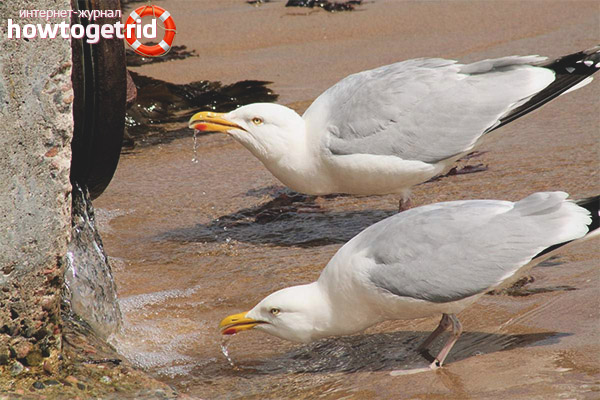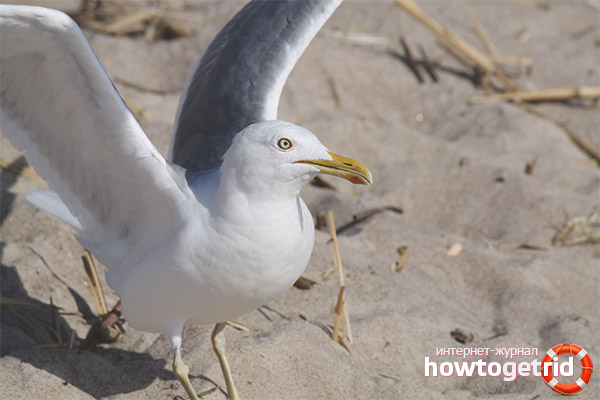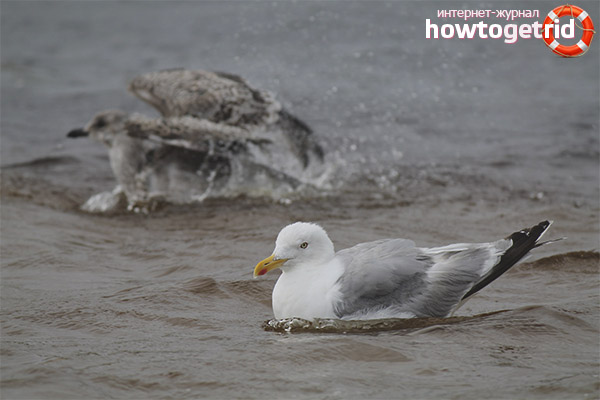The content of the article
The silver gull belongs to the order Charadriiformes, among all other representatives of the species of birds it is the most recognizable and common. The distribution area of the gull is so vast that the overwhelming majority of ornithologists are convinced that there are immediately a number of closely related birds.
Habitat
Mostly silver gull lives in cool regions, widely inhabiting the Northern Hemisphere. During the winter cold weather, flocks are sent to the south of China, to Japanese lands, to Florida, to the Gulf of Mexico. Most often, the gull chooses the British lands, Iceland, Alaska and the eastern part of America, Canada, Scandinavia as the locality for nesting.
Considering that these birds are extremely dependent on water and the food located there, they inhabit coastal areas inhabiting rocks, swamps, and cliffs. The silver gull was surprisingly able to adapt to living in society, together with people, for this reason, does not hesitate to build nests on the roofs of buildings, in the attics of houses. They can be regularly observed in the coastal zone or in the city, which is adjacent to rivers, lakes and seas.
Bird appearance
A seagull is a fairly large bird. The weight of an adult bird is often more than 1.5 kg, and the body length is approximately 60 cm. There is a white plumage in the area of the head, neck and body of the gull. On the back and wings the color is light gray. The beak at the end bends, slightly flattened on the sides, yellow. However, under it is a speck of red.
The eyes of the gull are framed by a narrow strip of yellow skin. The iris is gray. What is noteworthy, the color of the plumage of the gull becomes light only in the fourth year of life. Up to this age, young birds and chicks have a motley color with a predominance of gray and dark brown shades. The plumage gradually becomes lighter after two years of life. The plumage on the head of young birds - representatives of this genus - has a brownish inconspicuous hue along with the iris of the eyes.
The nuances of reproduction and life expectancy
The silver gull is a monogamous bird. With rare exceptions, they create a pair once for the entire period of their life. The birds reach the age of puberty by the age of five. Silver gulls begin to return to their nest in late April, early May, as soon as the ice leaves the water surface.
During nesting, birds form real flocks and colonies. To erect nests, the seagull uses small feathers, shreds of wool. To do this, she chooses secluded places near cliffs, rocks, in dense bushes. Both partners are engaged in the construction of the nest. In addition, tree branches, dried algae, and moss are used as material.
On average, the clutch ranges from 2 to 4 eggs, whose shade is green-brown or light olive. The eggs are also covered with large spots of dark brown color. Both partners hatch the masonry.Moreover, when the female replaces the male, or vice versa, the birds try to very carefully and accurately turn the eggs.
After the incubation period, which takes about a month, ends, the offspring hatch into the light. Their small bodies are covered with a grayish fluff, in which specks of dark shades are clearly visible. After a couple of days, the chicks are already able to stand on their legs, and after another two days, small seagulls can leave their native nest for a short time without moving far away.
If there is a threat nearby, the chicks try to hide, hide. At the same time, it is quite difficult to distinguish them on the surface of the earth. For the flight, the chicks become prepared for 40-50 days of life. Both parents take turns bringing food to their cubs, burping it. Intensively developing chicks mainly eat fish.
Feeding silver gulls

It is worth pointing out that representatives of this bird species are omnivorous. Often they can be found close to sea ships and garbage dumps. Sometimes you can even see how a seagull steals eggs from the laying of another's birds or extraneous chicks.
Silvery seagulls feed vole mice, hamsters, small reptiles, and insect larvae for food. In addition, the diet of the seagull includes berries, crops, nuts and fruits, fish, worms and crayfish. A larger seagull without much effort takes food from smaller and timid representatives of the same breed.
The nuances of "cohabitation" with people
It should immediately be pointed out that representatives of this species of birds can quite unceremoniously deal with people. Silver gulls intensively populate cities and large modern buildings, erecting their nests directly on their roofs. Often, she can attack anything that could threaten her offspring. Again, there are regular cases when extremely grossed gulls right in the city could grab food from people's hands.
However, in recent years, a sad tendency toward a decrease in the number of silver gulls has been more clearly traced. In Europe, the population has almost halved. Experts justify such a decrease in the number of birds by exposure to harmful environmental factors, as well as a reduced volume of fish in the regions adjacent to the shores.
Despite this, gulls are mainly active in the daytime. In some cases, these birds can remain active for whole days. In particular, this is true for those birds that live in high latitudes, which are inherent in the polar day.
Features of bird behavior

The silver gull is characterized by specific vocalization. They can produce a fairly wide range of diverse sounds. In their arsenal there is a cackling, croaking, howling and even sounds reminiscent of meowing. However, in most situations, you can hear screams like laughter from them.
Silvery gulls usually gather in quite numerous colonies, including up to several hundred pairs. Sometimes you can see more rare, small flocks. Each pair of males and females has a private area, which is under their protection. If the colony is threatened by any enemy from the outside, then all the birds rally instantly in order to give a proper rebuff to the opponent and protect the relatives. But in quiet periods inside the colony, conflicts of their own can arise, often ending in attacks.
Remarkable facts
The silver gull tries to observe clear hierarchical conditions in a colony or pair. The leader and leader will certainly be a male who will always make decisions and make choices for his chosen one. The latter will only deal with those problems that may arise during the arrangement and construction of the nest.
In addition, almost every bird that belongs to this species exhibits a kind of laziness: it prefers not to search for prey and food for itself on its own, making efforts. A silver gull is more comfortable with taking food from other relatives, birds or animals.
Video: silver gull - the difference between young and adult










Submit